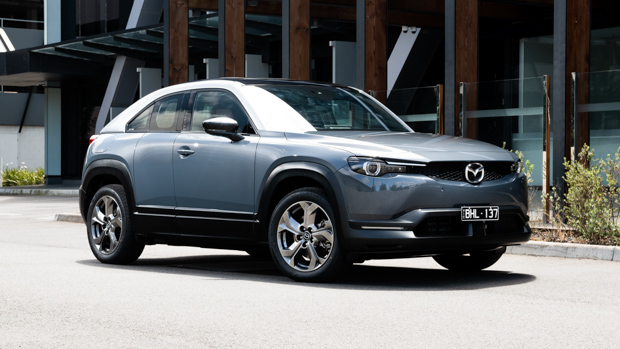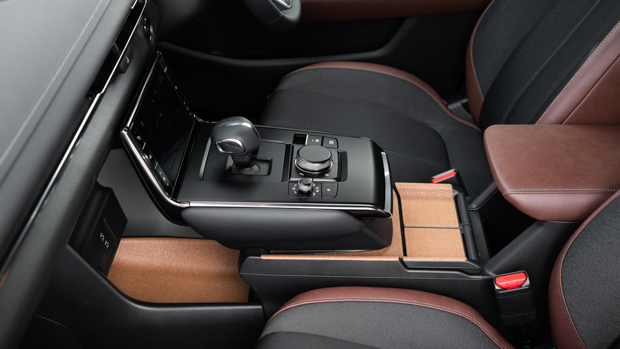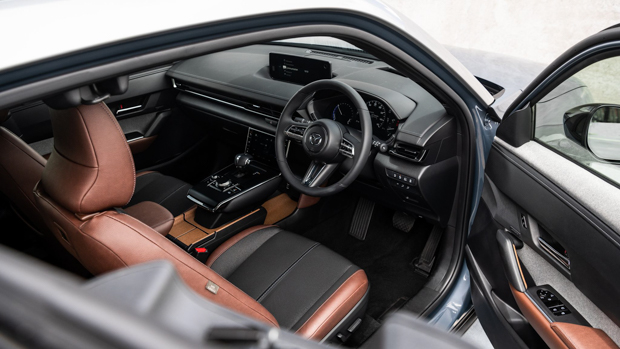-
Car Reviews
- Car News
-
Car Comparisons
Latest comparisons
- Chasing Deals
We drive a late-stage prototype of Mazda’s first electric vehicle, the MX-30 small SUV – and come away impressed

It is the philosophy of Japanese manufacturer Mazda that the internal combustion engine still has considerable life left in it. Untapped thermal efficiency improvements, higher compression and mild hybrid systems are all making their way into this company’s petrol and diesel engines – to which the brand is committed. However, Mazda are savvy enough to hedge their bets.
And this is the first such hedge: the 2021 Mazda MX-30 Electric. The brand’s first production electric vehicle, the MX-30 is a small SUV that assumes about the same dimensions as the popular petrol-fuelled CX-30, but with an entirely different, and particularly expressive, design.
Interestingly, the Mazda MX-30 is also coming to Australia with the CX-30’s two-litre naturally aspirated petrol engine, albeit with a very mild 24-volt hybrid system added in. The MX-30 M Hybrid, as the combustion version will be known, arrives in dealerships shortly.
Later – around mid-year – this all-electric version of the MX-30 will follow, undoubtedly at a price premium. However, many of the MX-30’s fundamental attributes indicate that this will be one of the more affordable EVs on the Australian market when it launches later in 2021.
In many ways, the Mazda MX-30 is unique among electric vehicles. It’s totally infused with Mazda’s philosophy of motoring: namely, a dual focus on driving enjoyment and efficiency. And that’s efficiency in the true sense: low consumption, but also only using as many resources as you need.
Chasing Cars has spent a considerable amount of time with senior Mazda executives in recent years who express their concern about what is called ‘well to wheel’ efficiency. In the case of EVs, it’s a question of whole-of-life consumption.
Twin concerns regarding the heavy weight of batteries, plus the considerable quantities of rare earth elements used to construct the lithium-ion cells that feed energy to electric vehicles, led the decision to give the MX-30 a particularly small battery.

Measuring in at just 35.5kWh, the MX-30’s battery is just under half the size of that you’ll find in a Hyundai Kona Electric. It’s essentially a third the size of the battery pack of an Audi e-tron SUV.
This decision has three major effects. The first, naturally, is a short range. The MX-30 is rated at just 224km of range on the notoriously optimistic NEDC cycle, so we expect real-world range to be under 200 kilometres. This is a city EV, and senior Mazda Australia execs are quite comfortable with that.
The second effect of this call is that the MX-30 is pretty light: at 1,645kg, the electric version is about 195kg heavier than a petrol Mazda CX-30. The Mazda EV will be, comfortably, one of the lightest electric cars on the market, endowing it with decent agility and boosting its energy efficiency.

By contrast, a Hyundai Kona Electric with 450km of Chasing Cars-tested range weighs 1,743kg, while the large Audi e-tron, with 392km of CC-tested range weighs a whopping 2,740kg. That said, the MX-30 could feasibly beat the range of the new MG ZS EV, which was just 191km in Chasing Cars real-world testing.
And the third impact? The MX-30 takes less of a toll on the planet to build. Until we reliably build batteries at scale without rare earth elements or fossil fuel-intensive production, this will be important.
But how does it drive? We ventured to what was once GM Holden’s proving ground at Lang Lang – now owned by Vietnamese EV startup Vinfast – to find out.

Lang Lang has a punishing ride and handling circuit of about 4km in length that was used to hone the properties of generations of Holden Commodores with varying success, though this was the very site where the superb VE-VF chassis was tuned and signed off.
Safe to say that Lang Lang’s ride and handling course is an accurate reflection of a really tough Australian country road – and the MX-30 feels right at home.
Driven back to back with the separately reviewed hybrid version, the MX-30 Electric benefits from having its (higher) mass situated further back and much lower, beneath the passenger cell. You’ll read it in every EV review, but yes, this effectively lowers the centre of gravity and helps the MX-30 Electric feel balanced and centred.

But the disciplined, low weight of the MX-30 means that a complicated suspension setup is not required in order to provide this SUV with solid bump absorption. There’s no doubt the spring and damper package has been tweaked to cope with the circa-200kg higher mass of the Electric version, but there’s a real sense of lightness of foot beneath the MX-30.
Turn-in is essentially immediate, with crisp steering that feels just as free of corruption as the rest of this brand’s highly-rated SUVs. There is a motor sitting under the short bonnet, but this weighs considerably less than a petrol engine, so the MX-30’s responses to steering inputs are quick.
Like with the CX-30, there is some body roll when pitching the MX-30 Electric into a bend, but this feels natural and is essentially designed in: Mazda stand behind a bit of body roll as the expected response from a car.

The stability control system of the MX-30 we drove reacted a bit more than we’d expect, but we were going hard over a pockmarked course with plenty of off-camber corners.
Our overall impression was that the MX-30 offers very decent, engaging handling. There’s no doubt this SUV is more fun to drive than a Nissan Leaf of Hyundai Kona Electric. In many ways, it feels like a more balanced combustion-engined Mazda crossover. And that’s the point.
Producing 107kW of power and 271Nm of torque, the MX-30 is not an EV powerhouse. Again, Mazda say this was a conscious choice – a decision to create an electric vehicle that behaves in a way that is really familiar for those stepping up from combustion vehicles.

There is still surprisingly strong step-off acceleration with zero lag, in the way only an EV can accelerate – but mid-range acceleration is linear and not especially immediate. The MX-30 builds speed confidently but a Kona Electric is faster.
Mazda has engineered a distinct sound into the MX-30 – another factor that helps to feel at ease if this is your first EV. It’s not the noise of a combustion engine, though it is somewhat similar – a rich, low tone that builds as your throttle pressure increases. We quite liked it.
Regenerative braking is weaker in the MX-30 than in some EVs, too. This is unlikely to be to the taste of those that have already become used to a Tesla, which offer genuine one-pedal driving – not something the MX-30 offers. The regeneration can be turned up, but you’ll still be using the brake pedal to come to a complete stop.
We’ll save our comments on true refinement and the efficacy of the MX-30’s safety technologies until we can get the car onto a real Australian road with other traffic around and about.
The MX-30 Electric might share a basic footprint with its petrol-powered CX-30 sibling, but the design Mazda have incorporated inside and out is completely different.
Squared-off and edgy where this brand’s SUVs are normally curvy and organic, the MX-30 feels like a break in Mazda’s design philosophy.
Certainly, there will be no confusing the MX-30 with a CX-30 – or a CX-3 or CX-5 – when the set of Mazda crossovers are sitting side by side in the showroom.

The same is true inside, where the MX-30 debuts a range of new design elements for Mazda, including a very cool cascading centre console incorporating a dedicated climate-control touchscreen.
There are still physical buttons for all key controls but there is a higher-tech factor at play inside the MX-30. By contrast, the super-plush but rounded CX-30 cabin feels old-school classy – you’ll probably like one or the other.
Some elements are shared, including the MX-30’s 8.8-inch central display that is, intelligently, still controlled by way of a fixed, rotary command dial located between the seats. Mazda’s relatively new software package is mature and intuitive, and thanks to the physical dial, easy and safe to manipulate on a bumpy road.

The car we tested, which did not have a stated grade, had integrated navigation, DAB digital radio and wired Apple CarPlay and Android Auto – but not the wireless version of those smartphone mirroring technologies, which Mazda is yet to launch on any of its cars.
In a cool touch, Mazda have incorporated cork as trim throughout parts of the cabin in a nod to the brand’s origins as a cork manufacturer 101 years ago – and the door caps are made of recycled PET bottles.
Vegan leather is found on the soft, elegant steering wheel, and on parts of the brown seats that we found to be relatively supportive – and electrically-adjustable for the driver.

There is decent practicality throughout the cabin, with cupholders topped with a cork phone holder, and door bins that will take a water bottle.
And there are back seats … accessed through Mazda’s ‘freestyle door’ concept that saw its most recent passenger car outing on the RX-8 coupe from earlier this century. They’ve also been used on the BT-50 king cab ute.
This means accessing the second row by first opening the front doors, and then unhooking the short back door. Safety is taken care of by the visibly huge chassis rails, Mazda say – and once nestled back there, there is certainly room for two adults.
But if you’re using the back seats regularly, obviously, a CX-30 or other conventional four-door car will make a lot more sense.

A first drive of the Mazda MX-30 Electric at Lang Lang left us wanting a much longer drive on real Australian roads.
This writer is not philosophically averse to short-range EVs with small batteries. The reality is that many Australian families have two vehicles: a wagon or larger SUV for long trips and family hauling duties, plus a smaller car next to it, used as a runabout.
It’s the latter job that the MX-30 is designed to complete – and complete with verve.

The MX-30 is not as powerful or flexible as its key rivals, but there is every chance it will also be a bit more affordable than them.
And of course, there is the Mazda-centric driver appeal and design that will pull fans of the brand in.
A full assessment is forthcoming, but first impressions are positive.
Key specs (as tested)
About Chasing cars
Chasing Cars reviews are 100% independent.
Because we are powered by Budget Direct Insurance, we don’t receive advertising or sales revenue from car manufacturers.
We’re truly independent – giving you Australia’s best car reviews.
The estimate provided does not take into account your personal circumstances but is intended to give a general indication of the cost of insurance, in order to obtain a complete quote, please visit www.budgetdirect.com.au. Estimate includes 15%^ online discount.
^Conditions Apply
Budget Direct Insurance arranged by Auto & General Services Pty Ltd ACN 003 617 909(AGS) AFSL 241 411, for and on behalf of the insurer, Auto & General Insurance Company Limited(ABN 42 111 586 353, AFSL 285 571).Because we don’t know your financial needs, we can’t advise you if this insurance will suit you. You should consider your needs and the Product Disclosure Statement before making a decision to buy insurance. Terms and conditions apply.
Indicative quote based on assumptions including postcode , 40 year old male with no offences, licence suspensions or claims in the last 5 years, a NCD Rating 1 and no younger drivers listed. White car, driven up to 10,000kms a year, unfinanced, with no modifications, factory options and/or non-standard accessories, private use only and garaged at night.
^Online Discounts Terms & Conditions
1. Discounts apply to the premium paid for a new Budget Direct Gold Comprehensive Car Insurance, Third Party Property Only or Third Party Property, Fire & Theft Insurance policy initiated online on or after 29 March 2017. Discounts do not apply to optional Roadside Assistance.
2. Discounts do not apply to any renewal offer of insurance.
3. Discounts only apply to the insurance portion of the premium. Discounts are applied before government charges, taxes, levies and fees, including instalment processing fees (as applicable). The full extent of discounts may therefore be impacted.
4. We reserve the right to change the offer without notice.